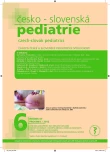A higher risk of terminal renal failure in Roma children – data from Slovak Pediatric Registry
Authors:
G. Koľvek; Ľ. Podracká
Authors‘ workplace:
1. Klinika detí a dorastu LF UPJŠ a DFN, Košice
prednostka prof. MUDr. Ľ. Podracká, CSc.
Published in:
Čes-slov Pediat 2012; 67 (6): 363-367.
Category:
Original Papers
Overview
Objectives:
Ethnic differences in the occurrence of end-stage renal disease (ESRD) are reported on various populations across of the world, but evidence on Roma fully lacks. The aim of this study was to explore the relative risk (RR) of ESRD for Roma.
Methods:
Ethnicity was assessed in children with ESRD who underwent renal replacement therapy during 2005–2009. RR of ESRD for Roma was calculated comparing occurrence of ESRD in Roma and non-Roma children. Calculation was repeated after standardization for differences in age of both populations.
Results:
Roma represented 25.0% of all patients with ESRD. The RR of ESRD for Roma was 1.56, compared to the majority population. After age-standardization the RR for Roma was 1.72.
Conclusion:
Results of this study on Slovak dialyzed children show that the risk for ESRD is significantly higher for Roma than for non-Roma. A genetic propensity of Roma to renal failure may partially explain the higher risk. Moreover, another significant factors possibly play a role, particularly consanguinity as well as different attitude towards own health.
Key words:
Roma, end-stage renal disease, incidence, prevalence, etiology
Sources
1. U. S. Renal Data System, USRDS 2009 Annual Data Report. Atlas of Chronic Kidney Disease and End-Stage Renal Disease in the United States, 2009.
2. McDonald S, Excell L, Jose M. The 33rd Annual Report 2010 Report – Data to 2009.
3. Agarwal SK, Srivastava RK. Chronic kidney disease in India: challenges and solutions. Nephron Clin Pract 2009; 111: c197–203.
4. ERA-EDTA Registry 2008 Annual Report, ERA-EDTA Registry, 2010.
5. Modi GK, Jha V. The incidence of end-stage renal disease in India: a population-based study. Kidney Int 2006; 70: 2131–2133.
6. Prabahar MR, Chandrasekaran V, Soundararajan P. Epidemic of chronic kidney disease in India – what can be done? Saudi J Kidney Dis Transpl 2008; 19: 847–853.
7. Lightstone L. Preventing renal disease: the ethnic challenge in the United Kingdom. Kidney Int 2003; 83 (Suppl): S135–138.
8. Tripathi G, Sharma RK, Baburaj VP, et al. Genetic risk factors for renal failure among north Indian ESRD patients. Clin Biochem 2008; 41: 525–531.
9. Zeman CL, Depken DE, Senchina DS. Roma health issues: a review of the literature and discussion. Ethn Health 2003; 8: 223–249.
10. Vano B. Projection of Roma population in Slovakia until 2025. Bratislava: Akty, 2002.
11. Koupilova I, Epstein H, Holcik J, et al. Health needs of the Roma population in the Czech and Slovak Republics. Soc Sci Med 2001; 53: 1191–1204.
12. Kröhnert S, Hossmann I, Klingholz R. Europe’s demographic future Growing Regional Disbalances. Munich: The Berlin Institute for Population and Development, 2008.
13. Sakhuja V, Sud K. End-stage renal disease in India and Pakistan: burden of disease and management issues. Kidney Int 2003; 83 (Suppl): S115–118.
14. Statistical Office of Slovak Republic. Stav a pohyb obyvateľstva, 2011. http://portal.statistics.sk/showdoc.do?docid=5639.
15. Rothman KJ, Greenland SG, Lash TL. Modern Epidemiology. Philadelphia: Lippincott Williams & Wilkins, 2008.
16. Barker DJ, Martyn CN. The maternal and fetal origins of cardiovascular disease. J Epidemiol Community Health 1992; 46: 8–11.
17. Bobak M, Dejmek J, Solansky I, et al. Unfavourable birth outcomes of the Roma women in the Czech Republic and the potential explanations: a population-based study. BMC Public Health 2005; 5: 106.
18. Brenner BM, Chertow GM. Congenital oligonephropathy and the etiology of adult hypertension and progressive renal injury. Am J Kidney Dis 1994; 23: 171–175.
19. Rimarova K, Ostro A, Bernasovska K, et al. Reproductive indicators of Roma mothers: cross-sectional study. In: Aghova L (ed). Living Conditions and Health. 1. vyd. Bratislava: Public Health Office of the Slovak Republic, 2004: 1–110,
20. Lemley KV. A basis for accelerated progression of diabetic nephropathy in Pima Indians. Kidney Int 2003; 63 (S83): S38–42.
21. Hurtado A, Johnson RJ. Hygiene hypothesis and prevalence of glomerulonephritis. Kidney Int 2005; 97 (Suppl): S62–67.
22. Van Cleemput P, Parry G, Thomas K, et al. Health-related beliefs and experiences of gypsies and travellers: a qualitative study. J Epidemiol Community Health 2007; 61: 205–210.
23. Petek D, Rotar Pavlic D, Svab I, et al. Attitudes of Roma towards smoking: a qualitative study in Slovenia. Croat Med J 2004; 47: 344–347.
Labels
Neonatology Paediatrics General practitioner for children and adolescentsArticle was published in
Czech-Slovak Pediatrics

2012 Issue 6
- What Effect Can Be Expected from Limosilactobacillus reuteri in Mucositis and Peri-Implantitis?
- The Importance of Limosilactobacillus reuteri in Administration to Diabetics with Gingivitis
Most read in this issue
- Quality of life and morbidity in children after repair of congenital diaphragmatic hernia
- Difficulties in prenatal diagnostics trisomy 20 and its mosaic
- Acute disseminated encephalomyelitis – case report
- Diagnostics and therapy of neurogenic bladder in children
